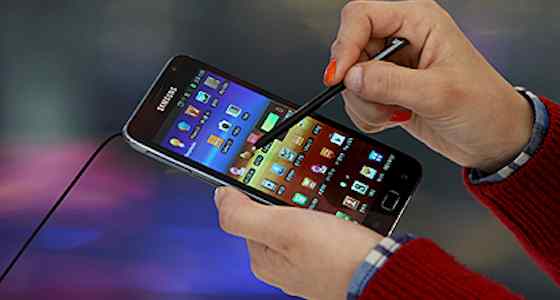- MENU
- HOME
- SEARCH
- WORLD
- MAIN
- AFRICA
- ASIA
- BALKANS
- EUROPE
- LATIN AMERICA
- MIDDLE EAST
- United Kingdom
- United States
- Argentina
- Australia
- Austria
- Benelux
- Brazil
- Canada
- China
- France
- Germany
- Greece
- Hungary
- India
- Indonesia
- Ireland
- Israel
- Italy
- Japan
- Korea
- Mexico
- New Zealand
- Pakistan
- Philippines
- Poland
- Russia
- South Africa
- Spain
- Taiwan
- Turkey
- USA
- BUSINESS
- WEALTH
- STOCKS
- TECH
- HEALTH
- LIFESTYLE
- ENTERTAINMENT
- SPORTS
- RSS
- iHaveNet.com: Technology
by John Moore

Larger than a smartphone, smaller than a tablet and equipped with a stylus, the phablet has emerged as a subset of the mobile device category.
Samsung's Galaxy Note, which entered the U.S. market earlier this year, is perhaps the best-known example. The Android-based product includes a 5.3-inch touch screen and a stylus, which Samsung had dubbed "S Pen." LG's Optimus Vu has also rolled out a 5-inch Android device that's equipped with a stylus, which launched in South Korea in March. Other mobile players are likely to follow, especially now that Samsung's phablet sales have eclipsed the 5 million unit mark.
Josh Flood, senior analyst with ABI Research, says he believes phablets compete with 6- to 8-inch tablets and premium smartphones. Last year, 6- to 7-inch tablets accounted for 6 percent of total tablet shipments (about 3.7 million units). Flood expects the bulk of the tablet market to remain in the 9-inch-plus range for the next 5 years.
So what type of buyer will spring for a phablet?
"Many of the handset vendors and operators believe the initial typical user will be what they term ‘feature chasers,'" explains Flood. "Additionally, users who are less concerned about data consumption will be prime targets for phablets, as they desire a greater Web-browsing experience and better graphics from sites such as YouTube."
Impact on Mobile Developers
The phablet's stylus, coupled with the larger display, will provide the greatest hook for mobile developers, according to industry watchers.
"The stylus is a very important thing that has finally come back to handheld mobile devices," says Mike Newman, president of On the GoWARE, a Los Angeles firm that specializes in mobile development, developer training and recruitment.
Styluses were widely used with mobile devices a decade ago, but the rise of the iPhone made them unfashionable, says Newman. He'd like to see the stylus stick around this time: "It opens up a whole other realm of creativity you can have with your software."
A stylus gives mobile application developers an extra feature to look at and play with, says Flood. "Application developers can now include an extra dimension in their apps, with pressure sensitivity as a key feature of the S Pen."
Stylus-friendly Apps
At this point, stylus-oriented applications are limited to drawing, sketching and note-taking, says Flood. He points to Graffiti, WritePad, 7notes, PhatPad and MyScript Memo as examples.
But the stylus presents plenty of opportunities for other app categories. For example, Flood says gaming applications may start using the stylus substantially over the next three to six months. In a simple football game, the pressure of the stylus could indicate the power of the quarterback's pass, he notes.
And the stylus may have an even greater impact on the brain and puzzle segment of mobile gaming, says Flood. "The stylus will enable users to navigate puzzles and flick between solutions at a quicker and more stimulating pace."
For user interfaces, the opinions are mixed. A stylus' precision input could lead to richer apps and user interfaces overall, says Newman. While a desktop developer can integrate many controls into an application's UI, mobile applications tend to be "dumbed down" to aid with navigation and accommodate fingers. But Flood doesn't think the stylus will influence user interface design -- at least for general use. "The majority of users will still prefer to use their fingers to operate their phones' operating system," he says.
Building From Scratch
Samsung recently unleashed mobile developers on stylus-driven applications. In April, the company invited developers to build stylus-integrated apps using the S Pen SDK. Voting is still going on, but the top apps will receive $205,000 in cash and prizes. The apps submitted covered a range of functions, from diagramming football plays to applying makeup.
Developers should start from scratch when building apps for phablets, says Naga Hariharan, director of product management at Quickoffice, which makes mobile office-productivity software. Don't just throw a smartphone or tablet app on a phablet. Take the nuances of this new form factor into account and consider how users interact with this particular device, says Hariharan. How users accomplish a task such as highlighting text and moving it around a document will unfold a lot differently via finger touch versus the fine control of the S Pen. "Create an application that is custom-fit for that device and you have a better chance of succeeding," he says.
Photo: Getty Images